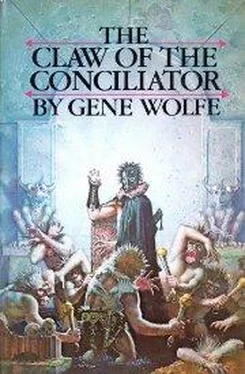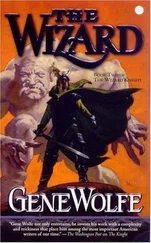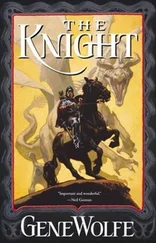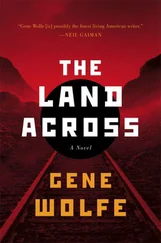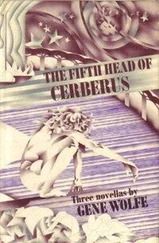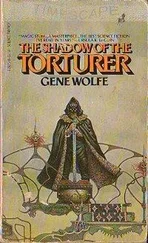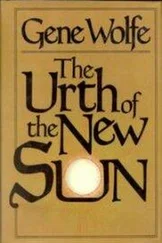“Severian!”
It was Dorcas. I started to rise, and my hand touched cloth as well as mud. I seized it and pulled it free — a long, narrow strip of silk tipped with tassels.
“Severian!” There was terror in the cry.
“Here!” I called. “I’m down here!” Another flash showed me the building and Dorcas’s frantic figure silhouetted on the roof I circled the blind walls and found the steps. Our mounts were gone. On the roof, so were the witches; Dorcas, alone, bent over the body of Jolenta. By lightning, I saw the dead face of the waitress who had served Dr. Talos, Baldanders, and me in the café in Nessus. It had been washed clean of beauty. In the final reckoning there is only love, only that divinity. That we are capable only of being what we are remains our unforgivable sin.
Here I pause again, having taken you, reader, from town to town — from the little mining village of Saltus to the desolate stone town whose very name had long ago been lost among the whirling years. Saltus was for me the gateway to the world beyond the City Imperishable. So too, the stone town was a gateway, a gateway to the mountains I had glimpsed through its ruined arches. For a long way thereafter, I was to journey among their gorges and fastnesses, their blind eyes and brooding faces.
Here I pause. If you wish to walk no farther with me, reader, I do not blame you. It is no easy road.
Social Relationships in the Commonwealth
One of the translator’s most difficult tasks is the accurate expression of matter concerned with caste and position in terms intelligible to his own society. In the case of The Book of the New Sun , the lack of supportive material renders it doubly difficult, and nothing more than a sketch is presented here.
So far as can be determined from the manuscripts, the society of the Commonwealth appears to consist of seven basic groups. Of these, one at least seems completely closed. A man or woman must be born an exultant, and if so born, remains an exultant throughout life. Although there may well be gradations within this class, the manuscripts indicate none. Its women are called “Chatelaine,” and its men by various titles. Outside the city I have chosen to call Nessus, it carries on the administration of day-to-day affairs. Its hereditary assumption of power is deeply at variance with the spirit of the Commonwealth, and sufficiently accounts for the tension evident between the exultants and the autarchy; yet it is difficult to see how local governance might be better arranged under the prevailing conditions — democracy would inevitably degenerate into mere haggling, and an appointive bureaucracy is impossible without a sufficient pool of educated but relatively unmoneyed executives to fill its offices. In any case, the wisdom of the autarchs no doubt includes the principle that an entire sympathy with the ruling class is the most deadly disease of the state. In the manuscripts, Thecla, Thea, and Vodalus are unquestionably exultants.
The armigers seem much like exultants, though on a lesser scale. Their name indicates a fighting class, but they do not appear to have monopolized the major roles in the army; no doubt their position could be likened to that of the samurai who served the daimyos of feudal Japan. Lomer, Nicarete, Racho, and Valeria are armigers.
The optimates appear to be more or less wealthy traders. Of all the seven, they make the fewest appearances in the manuscripts, though there are some hints that Dorcas originally belonged to this class.
As in every society, the commonality constitute the vast bulk of the population. Generally content with their lot, ignorant because their nation is too poor to educate them, they resent the exultants’ arrogance and stand in awe of the Autarch, who is, however, in the final analysis their own apotheosis. Jolenta, Hildegrin, and the villagers of Saltus all belong to this class, as do countless other characters in the manuscripts.
Surrounding the Autarch — who appears to distrust the exultants, and no doubt with good reason — are the servants of the throne. They are his administrators and advisors, both in military and civil life. They appear to be drawn from the commonality, and it is noteworthy that they treasure such education as they have obtained. (For contrast, see Thecla’s contemptuous rejection of it.) Severian himself and the other inhabitants of the Citadel, with the exception of Ultan, might be said to belong to this class.
The religious are almost as enigmatic as the god they serve, a god that appears fundamentally solar, but not Apollonian. (Because the Conciliator is given a Claw, one is tempted to make the easy association of the eagle of Jove with the sun; it is perhaps too pat.) Like the Roman Catholic clergy of our own day, they appear to be members of various orders, but unlike them they seem subject to no uniting authority. At times there is something suggestive of Hinduism about them, despite their obvious monotheism.
The Pelerines, who play a larger part in the manuscripts than any other holy community, are clearly a sisterhood of priestesses, accompanied (as such a roving group would have to be in their place and time) by armed male servants. Lastly, the cacogens represent, in a way we can hardly more than sense, that foreign element that by its very foreignness is most universal, existing in nearly every society of which we have knowledge. Their common name seems to indicate that they are feared, or at least hated, by the commonality. Their presence at the Autarch’s festival would seem to show that they are accepted (though perhaps under duress) at court. Although the populace of Severian’s time appears to consider them a homogeneous group, it appears likely that they are in fact diverse. In the manuscripts, the Cumaean and Father Inire represent this element.
The honorific I have translated as sieur would seem to belong only to the highest classes, but to be widely misapplied at the lower levels of society. Goodman properly indicates a householder.
Money, Measures, and Time
I have found it impossible to derive precise estimates of the values of the coins mentioned in the original of The Book of the New Sun . In the absence of certainty, I have used chrisos to designate any piece of gold stamped with the profile of an autarch; although these no doubt differ somewhat in weight and purity, it appears they are of roughly equal value.
The even more various silver coins of the period I have lumped together as asimi.
The large brass coins (which appear from the manuscripts to furnish the principal medium of exchange among the common people) I have called orichalks. The myriad small brass, bronze, and copper tokens (not struck by the central government, but by the local archons at need, and intended only for provincial circulation) I have called aes. A single aes buys an egg; an orichalk, a day’s work from a common laborer; an asimi, a well-made coat suitable for an optimate a chrisos, a good mount.
It is important to remember that measures of length or distance are not, strictly speaking, commensurable. In this book, league designates a distance of about three miles; it is the correct measure for distances between cities, and within large cities such as Nessus.
The span is the distance between the extended thumb and forefinger — about eight inches. A chain is the length of a measuring chain of 100 links, in which each link measures a span; it is thus roughly 70 feet.
An ell represents the traditional length of the military arrow; five spans, or about 40 inches.
The pace, as used here, indicates a single step, or about two and a half feet. The stride is a double step.
The most common measure of all, the distance from a man’s elbow to the tip of his longest finger (about 18 inches), I have given as a cubit. (It will be observed that throughout my translation I have preferred modern words that will be understandable to every reader in attempting to reproduce — in the Roman alphabet — the original terms.)
Читать дальше
